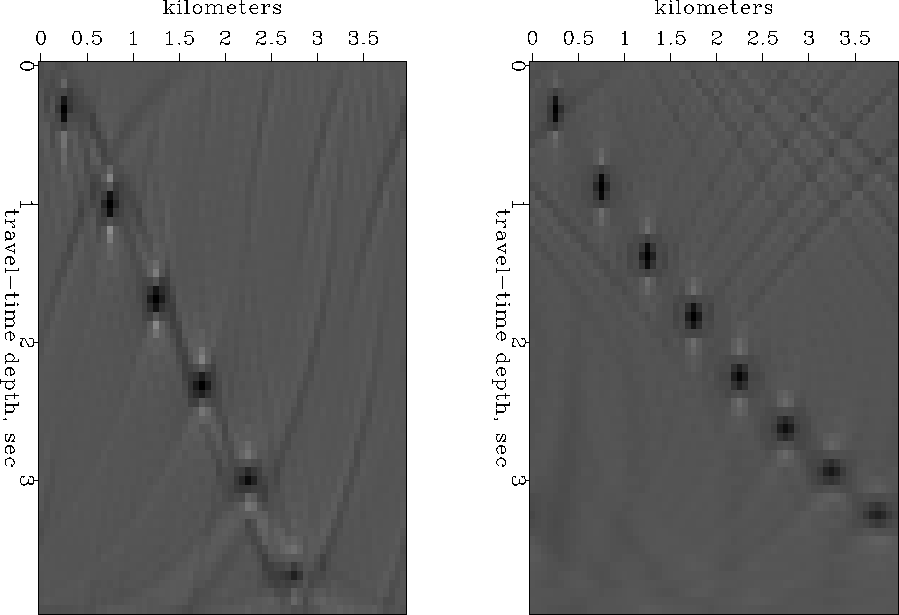 |
Figure 13 Left is migration back to a focus with a constant, water-velocity model. Right is the same, but with a Gulf of Mexico velocity, i.e. the hyperboloids of Figure 12 migrated back to focuses. Observe focus broadening with depth.
Horizontal resolution works a little differently. Migration is said to be ``good'' because it increases spatial resolution. It squeezes a large hyperbola down to a tiny focus. Study the focal widths in Figure 13. Notice the water-velocity focuses hardly broaden with depth. We expect some broadening with depth because the late hyperbolas are cut off at their sides and bottom (an aperture effect), but there is no broadening here because the periodicity of the Fourier domain means that events are not truncated but wrapped around.
 |
When the velocity increases with depth, wider focuses are found at increasing depth. Why is this? Consider each hyperbola to be made of many short plane wave segments. Migration moves all the little segments on top of each other. The sharpness of a focus cannot be narrower than the width of each of the many plane-wave segments that superpose to make the focus. The narrowest of these plane-wave segments is at the steepest part of a hyperbola asymptote. Deeper reflectors (which have later tops) have less steep asymptotes because of the increasing velocity. Thus deeper reflectors with faster RMS velocities have wider focuses so the deeper part of the image is more blurred.
A second way to understand increased blurring with depth
is from equation (12),
that the horizontal frequency ![]() is independent of depth.
The steepest possible angle occurs when
is independent of depth.
The steepest possible angle occurs when ![]() .Thus, considering all possible angles,
the largest |kx| is
.Thus, considering all possible angles,
the largest |kx| is ![]() .Larger values of horizontal frequency |kx|
could help us get narrower focuses,
but the deeper we go (faster velocity we encounter),
the more these high frequencies are lost
because of the evanescent limit
.Larger values of horizontal frequency |kx|
could help us get narrower focuses,
but the deeper we go (faster velocity we encounter),
the more these high frequencies are lost
because of the evanescent limit ![]() .The limit is where the ray goes no deeper but bends around and
comes back up again without ever reflecting.
Any ray that does this many times is said to be a surface-trapped wave.
It cannot sharpen a deep focus.
.The limit is where the ray goes no deeper but bends around and
comes back up again without ever reflecting.
Any ray that does this many times is said to be a surface-trapped wave.
It cannot sharpen a deep focus.